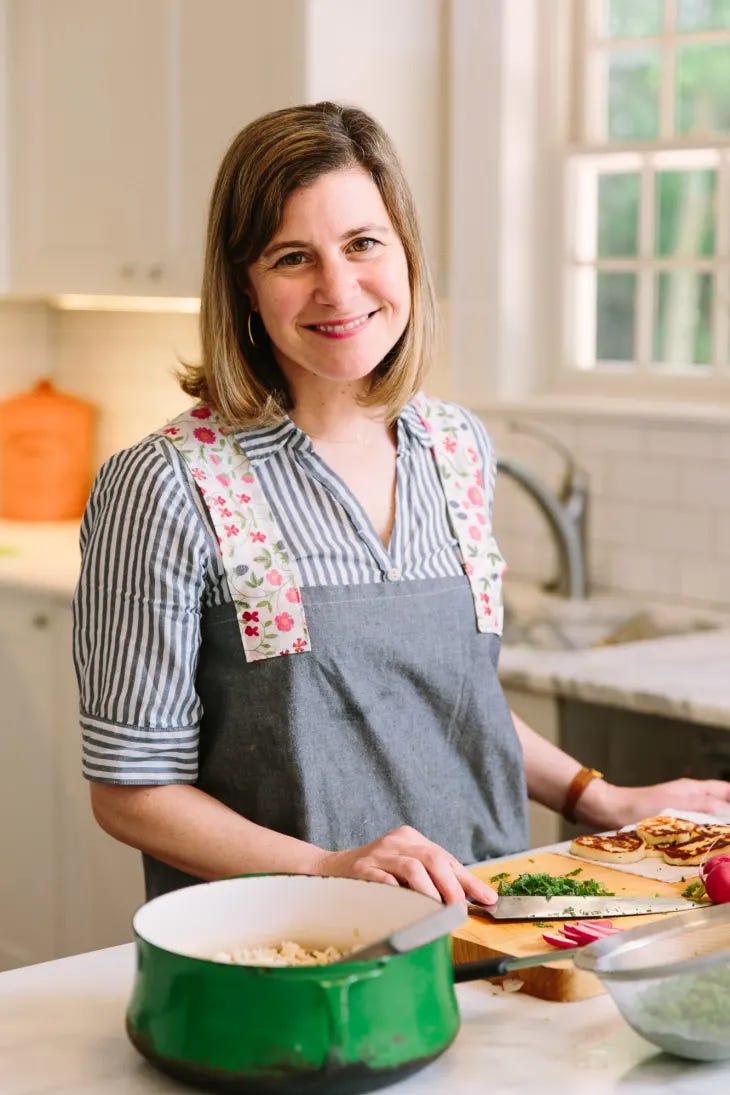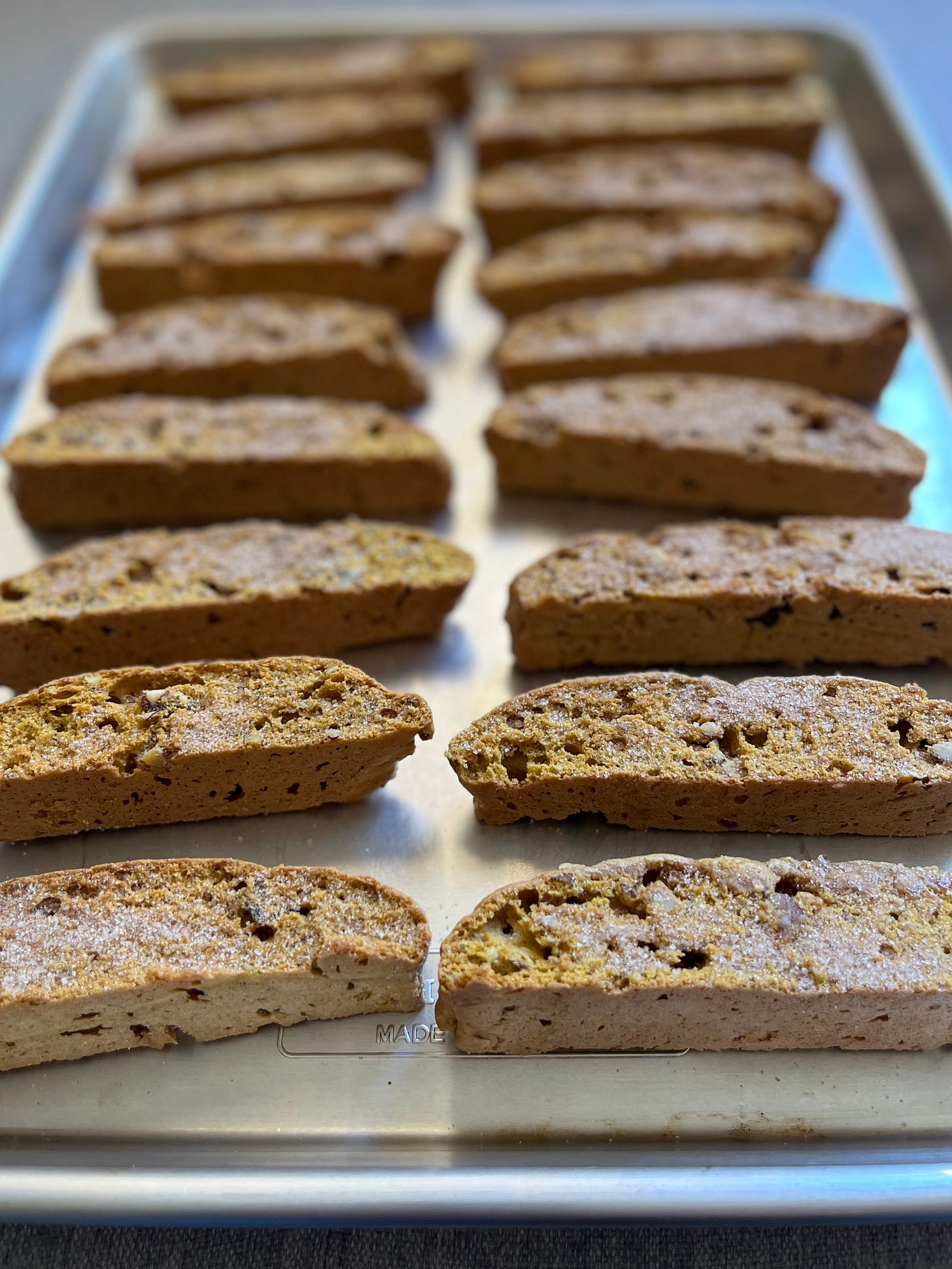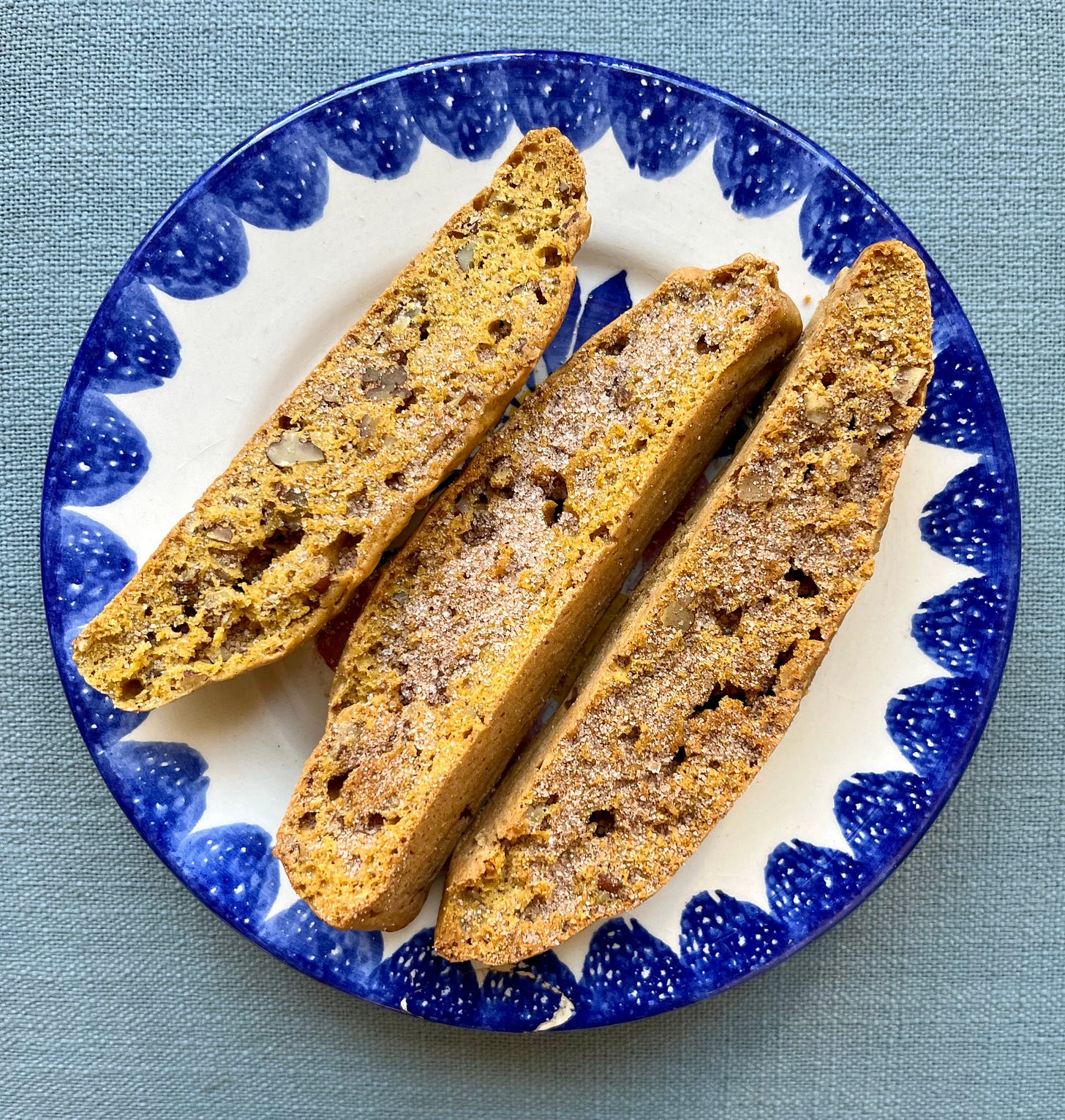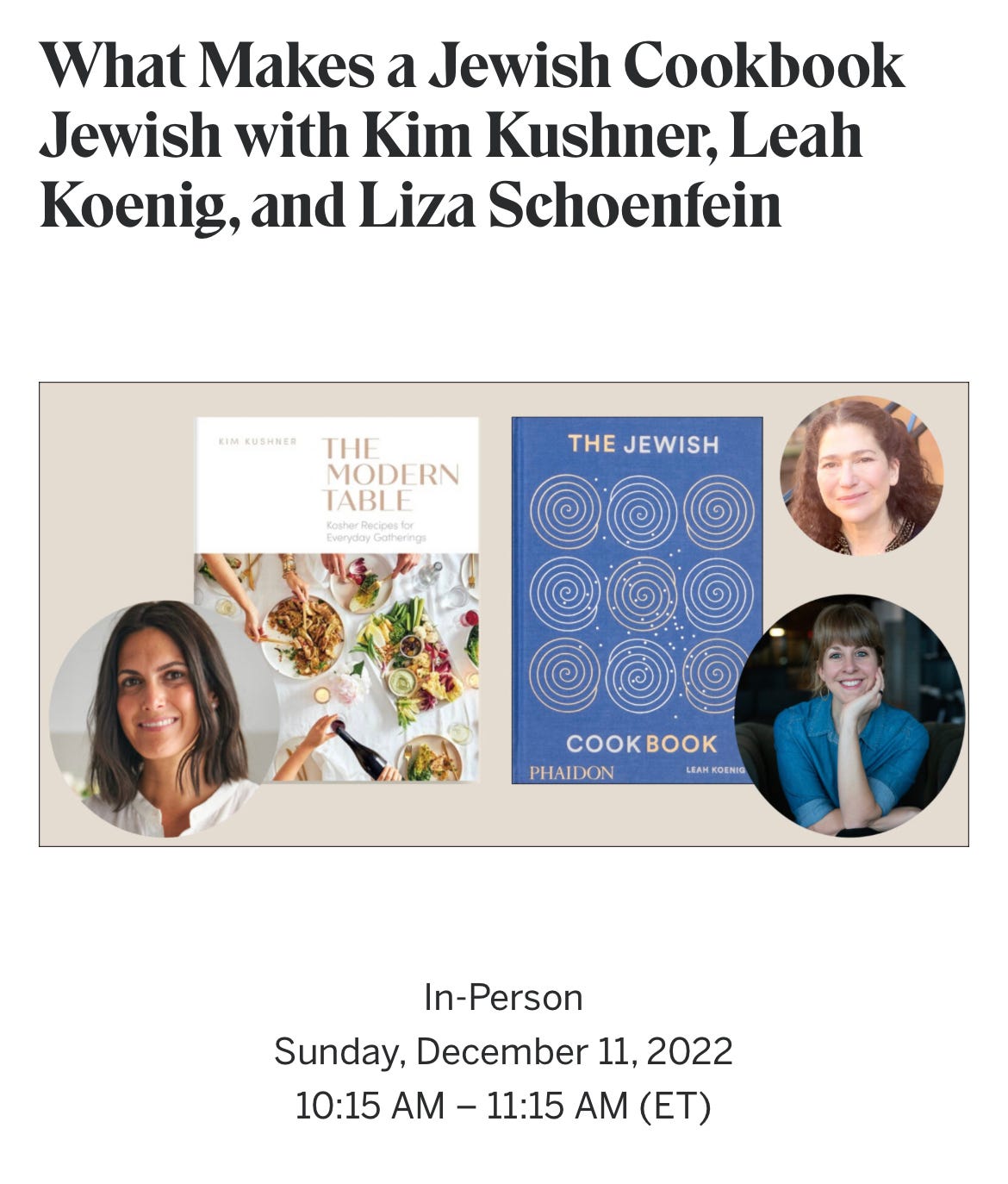Pumpkin Pie Mandelbrot
Plus: The Four Questions with Jenny Rosenstrach of Dinner: A Love Story
The Jewish Table is a reader-supported publication. If you are able, please consider becoming a paid subscriber (or gifting a subscription to a friend) so I can continue the research, writing, and recipe development it takes to bring you stories and recipes from around the Jewish globe. Thank you so much!
Mandelbrot are one of the unsung heroes of the Jewish pastry cannon. While they aren’t flashy like babka or decadent like cheesecake, they have a humble, everyday appeal that makes them irresistible.
A direct descendant of Italian biscotti, mandelbrot are twice baked, yielding a crunchy cookie that pairs very well with coffee and tea. Mandelbrot were originally flavored with almonds, which is how they got their name. (“Mandel” = almond and “brot” = bread in German/Yiddish.) But as they spread from Central to Eastern Europe, and then made their way to America, home cooks began filling the snappy cookies with everything from walnuts and dried fruit to chocolate chips.
My go-to mandelbrot recipe is based off of the one my mom, Carol, made when I was growing up. They were crisp, nutty, and generously blanketed with cinnamon-sugar. I absolutely adored them, and still do. My mom got the recipe from her friend, Dr. Minnie Frank, who was something of a surrogate grandmother to me. (My own bubbe, Bessie Sparber, passed away before I was born, so we spent a lot of Jewish holidays around Minnie’s table.) Where Minnie got the recipe…who knows? But I like to think that I’m at least the third generation of mandelbrot makers in this particular lineage.
In honor of Thanksgiving, I decided to mash up mandelbrot with the gourd-based star of the Thanksgiving dessert table: pumpkin pie. I swapped some of the butter (use non-hydrogenated margarine if you are keeping them dairy-free) with pumpkin puree, which gives them a wonderfully autumnal flavor. I also added ginger, cloves, and allspice to the more traditional cinnamon, and swapped chopped almonds for pecans in a nod to Thanksgiving’s other iconic pie.
Thanks to the added moisture the pumpkin puree adds to the batter, these mandelbrot have a relatively soft, tender bite with pockets of crunch a shimmery cinnamon-sugar cap. Did I consider calling them Pumpkin Spice Mandelbrot? I sure did - but only briefly.
I’m planning on serving these Pumpkin Pie Mandelbrot as part of a larger cookie platter for Thanksgiving. And the leftovers? Let’s just say they will be great dipped into last week’s recipe for Mulled Pomegranate Cider. Let me know if you make them - and happy Thanksgiving!
Pumpkin Pie Mandelbrot
Dress up these Pumpkin Pie Mandelbrot with generous handfuls of chocolate chips and/or roughly chopped dried cranberries. Or melt some semisweet baking chocolate and dip the ends in, then let the chocolate set in the fridge. You can also just leave them as is, which is what I usually do!
One note, if you have never made mandelbrot before: the batter is very soft - closer to cake batter than cookie dough. Use a sturdy spoon to scoop the batter onto the baking sheets, then use an offset spatula or butter knife to spread it out. If the batter is sticking, dip the spatula/knife into a little warm water and proceed.
Makes about 3 dozen cookies
3 cups (420 g) all-purpose flour
1 teaspoon baking powder
1 teaspoon baking soda
2 1/2 teaspoons ground cinnamon, divided
1 teaspoon ground ginger
1/2 teaspoon ground cloves
1/2 teaspoon ground allspice
1/2 teaspoon kosher salt
1 stick (1/2 cup/113 g) unsalted butter or non-hydrogenated margarine, at room temperature
1 1/4 cups (250 g) granulated sugar, divided
1/2 cup (120 g) pumpkin puree
4 large eggs
1 1/2 teaspoons vanilla extract
1 1/2 cups (160 g) pecan halves*, finely chopped
Preheat the oven to 350˚F, and line two large rimmed baking sheets with parchment paper. In a medium bowl whisk together the flour, baking powder, baking soda, 2 teaspoons of the cinnamon, the ginger, cloves, allspice, and salt.
In a stand mixer fitted with the paddle attachment (or using a handheld electric mixer), beat the butter and 1 cup (200 g) of the sugar at medium speed until pale and creamy, 2 to 3 minutes. Add the pumpkin puree, eggs, and vanilla extract and beat, scraping down the sides of the bowl as necessary, until fully incorporated. (The mixture will look curdled at this stage, that’s okay.)
Add the flour mixture in two additions, beating on low until just combined. With a rubber spatula, fold in the chopped pecans. The batter should be soft and spreadable.
Divide the batter into roughly four equal sections. Starting with two sections, scoop them out onto one of the prepared baking sheets, leaving about 2 inches of space in between each. Using a butter knife or offset spatula, spread each section of batter into a long, flat rectangle that is about 9x4 inches and no more than 1/2-inch thick. Repeat with the remaining batter and baking sheet. Bake until puffed and lightly browned, about 20 minutes. Remove from the oven and let cool for about 2 minutes. Meanwhile, stir together the remaining 1/4 cup (50 g) of sugar and the remaining 1/2 teaspoon of cinnamon in a small bowl.
Slice the rectangles, while still on the baking sheet, crosswise into 3/4-inch pieces, then turn the pieces onto their sides and sprinkle with about half of the cinnamon-sugar mixture. Bake for 10 minutes more, then remove from the oven, flip the cookies to the other side, and sprinkle with the remaining cinnamon-sugar. Bake until firm, about 10 minutes.
Remove from the oven and set the baking sheets on wire racks to cool for 5 minutes, then transfer the cookies to the racks to cool completely.
*Sending a quick thank you to my fellow Substacker, Anne Byrn, for turning me on to the pecans by Schermer Pecans - a family-run nut farm in Georgia. You can make these mandelbrot with any pecan, of course, but I really noticed the pecan flavor coming through in a big way!

The Four Questions: with Jenny Rosenstrach
Welcome to the latest installment of The Four Questions, The Jewish Table’s semi-regular interview segment featuring Jewish food luminaries. This week I’m beyond excited to be joined by Jenny Rosenstrach from Dinner: A Love Story.
Back in 1998, Jenny began chronicling what she ate for dinner. Every night, she would jot down a quick note of the meal in her notebook…and then she never stopped! In 2010, she transformed this obsession with dinner (as well as her adventures in feeding her two daughters) into the blog Dinner: A Love Story. Since then, she has written multiple cookbooks, most recently The Weekday Vegetarians (which is so good!), and started her own Substack newsletter, also called Dinner: A Love Story. I look forward to her newsletters every week. Jenny is also the regular food columnist for *another* of my all-time favorite websites, Cup of Jo.
I have been a fan of Jenny’s work for more than a decade. Even before I had kids of my own, I connected with her relatable approach to cooking, eating, and hosting others. When Modern Jewish Cooking came out, she posted about it on Dinner: A Love Story - and I’m telling you, I nearly fainted. Jenny Rosenstrach cooked my recipes?! And enjoyed them? A dream.
I’m honored that Jenny took the time to join us for this week’s The Four Questions interview. Read below to learn more about her connection to Jewish food (and her ideal Jewish meal), her recent transition to cooking as an “empty nester,” and how she and her family shifted their dinner habits away from always having meat at the center of the table.
1. How would you describe your relationship with Jewish food, and how has it changed over the years?
My relationship with Jewish food is so different from my relationship with other kinds of foods, because in like 90% of the cases, someone else is cooking it for me instead of the other way around. My father is Jewish and my mother is not, so when I was growing up all of our Jewish celebrations happened outside our home - at my aunt’s house or my uncle’s house. I never grew up organically absorbing the culinary traditions in my own kitchen.
Now my sister mostly hosts all the holidays and while, I always bring a dish, it’s different. This does not mean I don’t love Jewish food. Quite the opposite, I love it and seek it out when I can. But because I’m never the one hosting, I don’t feel like I have my One Kugel recipe or my One Brisket recipe or my One Latke recipe, the way I do with a lot of my other dishes. I do have my One Challah, thanks to a second cousin, and thanks to you, Leah, my One Matzoh Ball Soup with the fennel-spiked broth — no reason for me to look any further than that one.
2. What has surprised you most over the years about your Dinner a Love Story journey?
Well, for starters, the fact that any one person can love dinner this much for so long! Seriously, though. When I started writing the blog in 2010, meat anchored our dinner almost every night. I think the person writing back then would be pretty shocked to hear that her family has now become Weekday Vegetarians, dialing back the meat whenever possible. I think I would’ve also been surprised to hear that cooking plant-based wasn’t as hard as everyone made it out to be. Once I trained myself to use the vehicle as my starting point (am I in the mood for tacos? Pizza? Salad? Pasta?) instead of a piece of animal protein (I have a piece of chicken, what should I surround it with?) it was like the angels began to sing.
3. What is one thing you love about "empty nester" cooking, and one thing you miss about cooking for four on a regular basis?
It was fortuitous that I named this whole enterprise Dinner A Love Story — it truly is a story with many different chapters because the ritual itself is constantly evolving. Before I sent my kids off to college, I worried about what would happen to our dinner ritual — but in a lot of ways, it’s become even more important to me. When you’re cooking for kids, no matter how old they are and no matter how much you love to cook, it can still feel stressful. You have to cater to their unpredictable tastes and schedules. Just in terms of sheer volume, you have to produce a lot of food. It’s obviously incredibly rewarding, but now, when I’m cooking for two, I look forward to dinner more than I ever did. Mostly, I feel that it’s a little gift I can give myself every day. I don’t really see that ever changing at this point.
4. If you could sit down to your perfect "Jewish" meal (however you define that), what would be on the table - and who would be around it?
I don’t think there’s anything more perfect than a New York bagel spread with all the fixings — cream cheese, lox, minced onions, capers, tomatoes, lemon wedges. (Breakfast at Russ & Daughters cafe on the Lower East Side is my idea of heaven.) As for who is around that table, I’d like it to be my grandparents — on both my father’s Jewish side and my mom’s Presbyterian side. I never knew any of them because they all died before I was born, and I have so many questions, staring with: What is your go-to kugel?
Bonus Thanksgiving Content
Here are a few articles I’ve written over the years that explore the intersection of Jewish tradition and Thanksgiving. The green bean casserole is a personal fave - what a crazy and unexpected history!
To Brine or Not To Brine: Cooking Kosher Turkey for Thanksgiving (read)
Green Bean Casserole’s Jewish Pedigree (read)
How Cranberries Found a Place at the Jewish Table (read)
Upcoming Event, Sunday, Dec 11 @ 10:15am
I’m looking forward to being a part of this fun conversation at the New York Jewish Book Festival on Sunday, Dec 11. Here’s the link to register - I would love to see you there!





My mother made traditional mandelbrot with almonds. They were hard as rocks but great to dip in a hot drink. I’ve always been curious about the relationship between biscotti and mandelbrot because of the unmistakable similarities. I thought it was because the Jewish cookies were usually made with oil so as to be pareve, but these have butter, so maybe there is less difference than I thought. Anyway your recipe does sound delicious and perfect for Thanksgiving!
Love this once again, Leah! Definitely trying out this recipe.